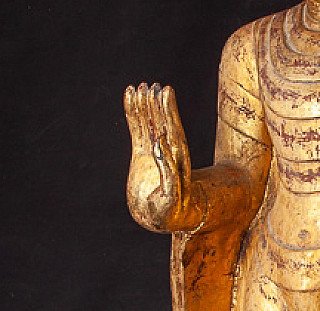Abhaya Mudra

The Abhaya mudra (mudra of no-fear) represents protection, peace, benevolence, and dispelling of fear.
In Theravada Buddhism, it is usually made with the right hand raised to shoulder height, the arm bent and the palm facing outward with the fingers upright and joined and the left hand hanging down while standing. In Thailand and Laos, this mudra is associated with the walking Buddha, often shown having both hands making a double Abhaya mudra that is uniform.
The mudra was probably used before the onset of Buddhism as a symbol of good intentions proposing friendship when approaching strangers.
In Gandhara art, it is seen when showing the action of preaching. It was also used in China during the Wei and Sui eras of the 4th and 7th centuries.
The gesture was used by the Buddha when attacked by an elephant, subduing it as shown in several frescoes and scripts. In Mahayana Buddhism, the northern schools' deities often paired it with another mudra using the other hand.
In Japan, when the Abhaya mudra is used with the middle finger slightly projected forward, it is a symbol of the Shingon sect.
Share this page













































